Introduction & Pricing and Availability

The Amped Wireless RTA15 is a dual-band wireless router, supporting 300 Mbps in the 2.4 GHz band and 867 Mbps utilizing the 5 GHz band. To boost the routers range, Amped Wireless has integrated two high power 2.4 GHz amplifiers, four two stage 5 GHz amplifiers, in addition to the four low noise amps and three high gain antennas.
Adding to the RTA15, we also have four gigabit Ethernet ports for connecting PCs, Network Storage and A/V devices at wire speeds. On the front of the device, you will find nine LEDs denoting everything from wireless connectivity to wired Ethernet activity and USB storage.
Let's get started now and see what this wireless router is all about.
Pricing and Availability
At this point in time, market price for the Amped Wireless RTA15 sits at $189.99, with a one year warranty.
Comparable units in the market are the ASUS RT-AC56U at $179.99, Linksys EA6300 at $199.99, Netgear R6200 at $159.99 and D-Link DIR 860L at $189.99.
Amped Wireless RTA15 Router

The Amped Wireless RTA15 arrived in an inviting package. On the front of the box there is an image of the router with claims of "longest range" and in bold lettering the use of its high power amplifiers at 700mw.
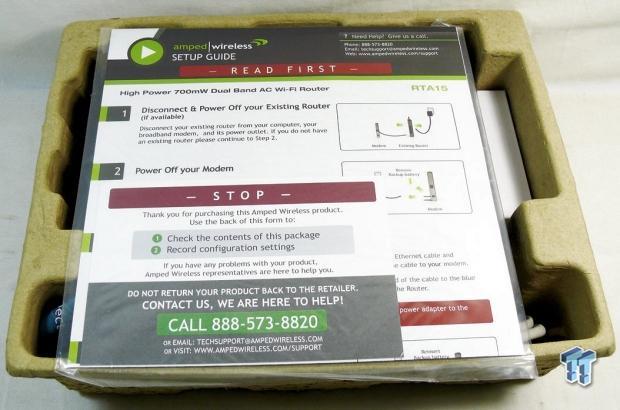
Internally the router was packaged in an egg crate material, which is pretty standard as far as routers go. Included we found setup instructions, along with disk to get us going.

The scope of delivery for the Amped RTA15 includes the power adapter, stand and three high gain antennas. The three antennas are numbered and require you to match them to the appropriate port on the back of the router.

The Amped Wireless RTA15 carries a high gloss exterior with the company logo placed in the center. Below you will find a set on nine LEDs to denote router activity across wireless, wired Ethernet and USB storage.

The back of the router is labeled and color coded for easy setup. The modem port is colored blue, while the remaining gigabit switch ports are green. The three wireless connections for the antennas are label 1, 2 and 3. Additionally, we have a WPS button and reset switch next to the USB storage port.

The internals of the RTA15 features a Realtek processor at the center operating at 660MHz. To the left, we have the RTL8367 switch that offers a 5 + 2 port configuration.
To the top, circled in red, we have the 5 GHz radio and four 26dbm amplifiers. In blue, we have the 2.4 GHz radio, along with two 28dbm amplifiers.
Router Setup and Management Interface

When first connecting to the router, you will be greeted by the setup menu. You can also access it via 192.168.3.1 or setup.ampedwireless.com. The unit comes with SSIDs secured from the factory, so you can do your initial setup wirelessly.

Walking through the menu system, be sure to plug all cables in at this point and double check your wireless antennas.

If you so choose, you have the option of using manual setup to configure your router to your needs or automatic where the router does everything for you.

Setup takes approximately 20 seconds to complete after which the router is ready to go.

The 5 GHz settings menu allows you to change SSIDs, what bands to broadcast on, in addition to the channel width 20, 40 or 80MHz.

Advanced settings for the 5 GHz band allows you configure Tx beamforming, among others.
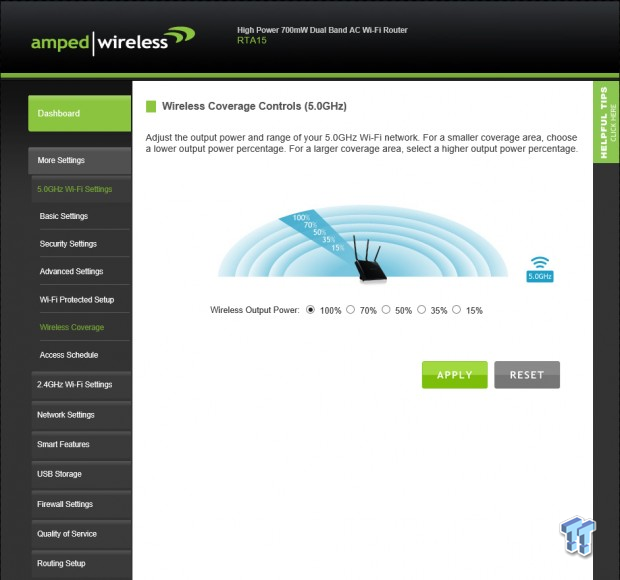
Moving to the wireless coverage menu item, you will find you can adjust the output power of the 5 GHz band.

Looking at the smart features, we find the option to block and filter websites.

You can configure your USB storage within the local sharing menu, additionally you can choose to setup an FTP server right on the router.

Firewall settings open up options for port filtering and port forwarding. Additionally, you will find DMZ and Virtual LAN options within this menu.

As of late, in the high-end of the consumer space, routers have begun to offer VLAN support. VLANs allow you to split or separate your network. One example would be to setup two VLANs in a home office environment to keep PCs that do not belong to the office off the same network.

Within the management menu, you can view network statistics, manage your dynamic DNS and upgrade firmware.
Benchmarks - Test System Setup
Test System Setup

As wireless networking has proliferated in homes and offices around the world, and network vendors keep releasing new devices on a regular basis, you now have so many options that it's hard to make a choice. The truth of the matter is, regardless of how many features a wireless router or access point has, the two most important things about it are its speed and its range.
We test throughput and range in a dual-node network environment consisting of a Custom PC with a GIGABYTE Z77UP5 TH, Intel Core i5 3570K Processor operating at 3.3 GHz with 16GB of DDR3 featuring the Startech.com ST1000SPEX42 quad port gigabit network adapter and a single HP ProLiant DL380 G5 Server with Windows Server 2012 R2 and a second Startech.com ST1000SPEX42.

Wireless throughput is tested using the ASUS PCE-AC68 PCI Express Network Adapter, while range is tested with a HP ProBook installed with an ASUS USB-AC56 adapter through USB 3.0.
We perform all tests in a real-world environment. You may get better range and throughput results in a spacious facility with few internal walls, or outdoors. Our tests provide a benchmark for estimating the range and throughput of wireless networking devices in an indoor setting, with some obstacles.
Benchmarks - Wired Throughput
Wired Throughput
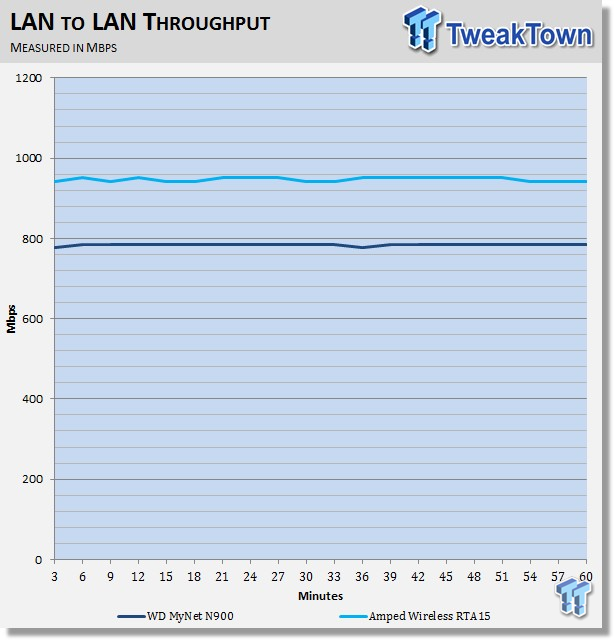
In LAN to LAN throughput, the Amped Wireless RTA15 did quite well. Here we see transfers moving near gigabit wire speed.

WAN to LAN throughput tests the routers ability to pass traffic from the internet to the switched ports.
Here we see the RTA15 offer steady performance throughout the testing period, peaking near 850 Mbps.
Benchmarks - Wireless Throughput
Wireless Throughput

Utilizing the 2.4 GHz band at 20 MHz, the RTA15 peaked at 95 Mbps.

On the 40 MHz channel width throughput was similar to what we found with the 20 MHz width.

Moving over to the 5 GHz band, wireless throughput peaked at 95 Mbps, again close to what we saw on the 2.4 GHz band.

At 40 MHz, the throughput of the RTA15 picked up quite a bit, peaking near 250 Mbps.

Testing the throughput of the RTA15 at 5 GHz 80 MHz, we find the router peaking just over 300 Mbps.
In addition, the large spike in throughput when the router moves from 200 Mbps to 300 Mbps shows us that Tx beamforming is indeed working.
Benchmarks - Wireless Range
Wireless Range
For wireless range, we need to refer back to the Network Infrastructure chart on page four of this article. Each chart herein is based on the locations on the table. To make it simple Location 1 is the closest and within Line of Sight while Location 4 is the furthest away with many walls in between. Location 5 tests the routers ability to generate enough signal strength to penetrate to the second floor of a home.

Our first chart shows the range of the RTA15 using the 2.4 GHz 20 MHz band. As you can see, the router was able to maintain a great signal rate throughout the first three locations, but dropped off sharply as we moved past 40 feet.

The 40 MHz width on the 2.4 GHz band allowed similar results to the previous test. Here we see the RTA15 maintain pretty good signal throughout.

Moving over to the 5 GHz band, we find the range to improve drastically when it comes to getting a signal on the second floor. Here we find the signal rate is the same -45dbm of Location 1.

5 GHz 40 MHz allows the same basic signal strength to floor above, while losing a bit of signal to Location 3.

5 GHz 80 MHz gave us a slight increase in signal strength to location 3. All other Locations carry the same signal as previous 5 GHz channels.
Benchmarks - Link Speed By Location and Power Consumption
Link Speed by Location
Link Speed by Location offers valuable insight into the working throughput of the router at specific locations.

At the 2.4 GHz 20 MHz band, we find the RTA15 to do very well through the entire range of testing. At its peak, it hits the maximum of the 20 MHz channel at 144 Mbps.

Moving to 40 MHz, we find the RTA15 hold onto the full 300 Mbps until we move out past 50ft, after which it connects at roughly 270 Mbps.

The 5 GHz 20 MHz band allows the router to connect at 180 Mbps within line of sight, moving out from the router the signal drops off rather quickly eventually connecting at 30 Mbps at location 4.
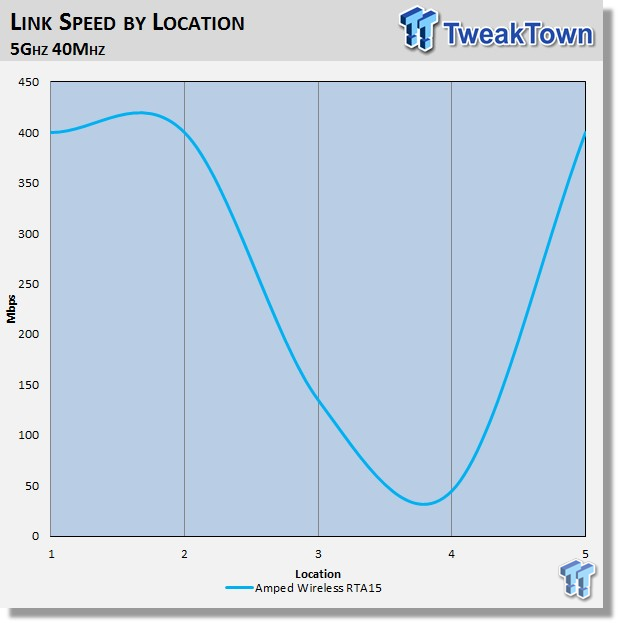
Using the 40 MHz channel width, we found the signal to do quite well through locations one and two. Moving our further, we connect at 150 Mbps at location three and 50 Mbps at location 4.
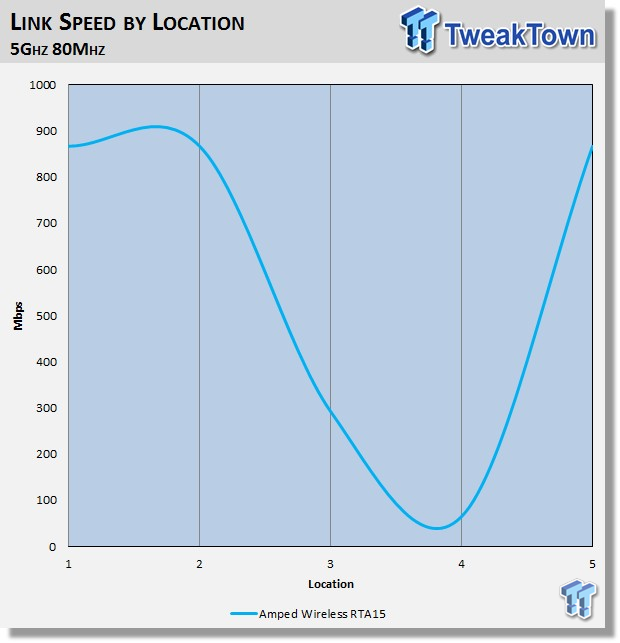
Firing up the 5 GHz 80 MHz band, we connect to the RTA15 at an impressive 867 Mbps within locations one and two. Moving out, we connect at 300 Mbps at location three and 90 Mbps at location 4.
Power Consumption

Power consumption figures were taken from our Kill-A-Watt meter throughout testing.
Here we find the RTA15 using 21 watts at its peak with an idle of 15 watts.
Final Thoughts

Aesthetically, the Amped Wireless RTA15 is one of the best looking routers I have ever tested. Additionally, the build quality of the router is quite good, with thick heavy plastic covering the internal components. The front mounted LEDs give a good indication of what's going on with the router, and the rear mounted USB port has become more of standard with routers these days.
As far as the management interface goes, the RTA15 offers one the most complete solutions available. The ability to control the channel width and lock it is a helpful feature in getting the most out of your network in situations where all your devices are N or AC only. Another feature I was impressed to find on the router was VLAN, as this has typically been exclusive to more expensive managed network switches.
Throughout testing, we did have a number of small issues getting the router to keep and maintain a steady wireless signal. I do, however, hope this issue will be fixed in the future with a firmware update, and we can revisit this router at a later date.
Even with these mishaps, the RTA15 isn't a bad router, it was able to give us wireless AC connection rates at distances up to 20ft, while the 2.4 GHz and 5 GHz 802.11n bands were able to maintain their connection rates past the capabilities of the WD MyNet N900. Across the four gigabit Ethernet ports, we managed near 950 Mbps throughput and 800 Mbps of throughput from WAN to LAN.
Pricing of the Amped Wireless RTA15 is at $189.99, which puts it at the top tier of the market, even more at this tier there is some pretty stiff competition from Linksys, Netgear and ASUS with their top of the line solutions. With this said, I do feel if they lowered the price even slightly, it would put them in position to have one of the best wireless router solutions in terms of price/performance.


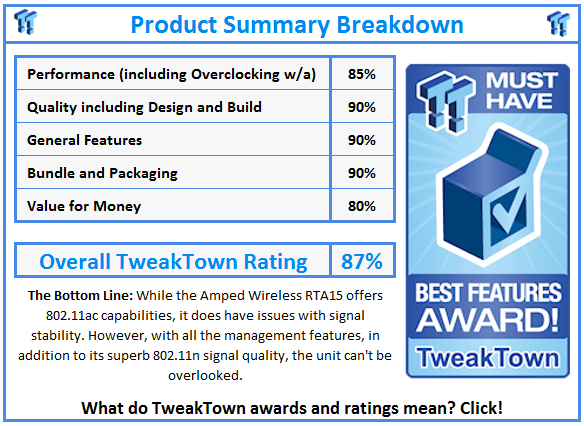
 United
States: Find other tech and computer products like this
over at
United
States: Find other tech and computer products like this
over at  United
Kingdom: Find other tech and computer products like this
over at
United
Kingdom: Find other tech and computer products like this
over at  Australia:
Find other tech and computer products like this over at
Australia:
Find other tech and computer products like this over at  Canada:
Find other tech and computer products like this over at
Canada:
Find other tech and computer products like this over at  Deutschland:
Finde andere Technik- und Computerprodukte wie dieses auf
Deutschland:
Finde andere Technik- und Computerprodukte wie dieses auf